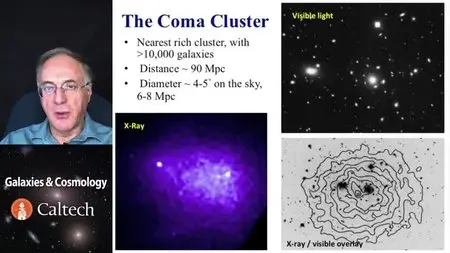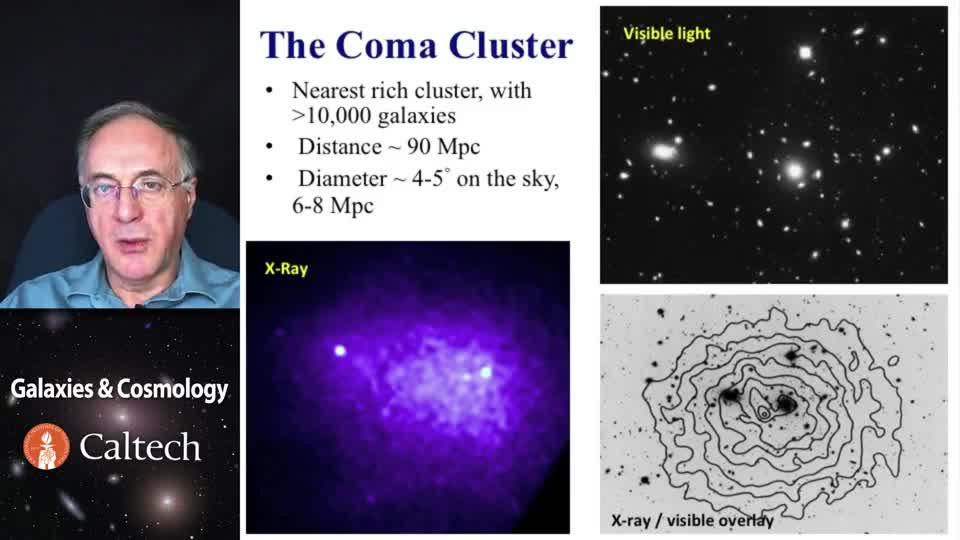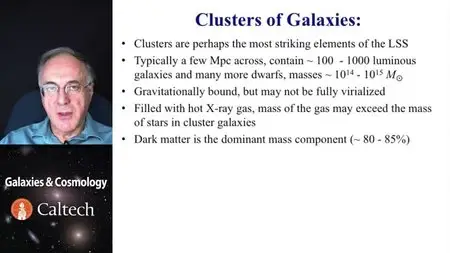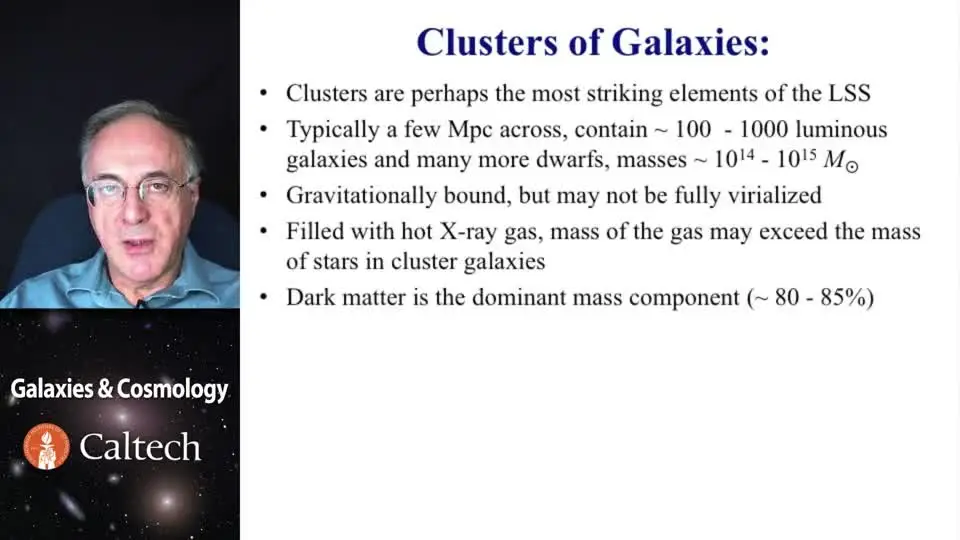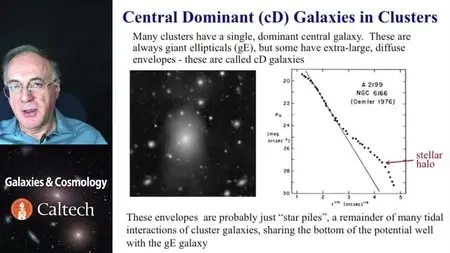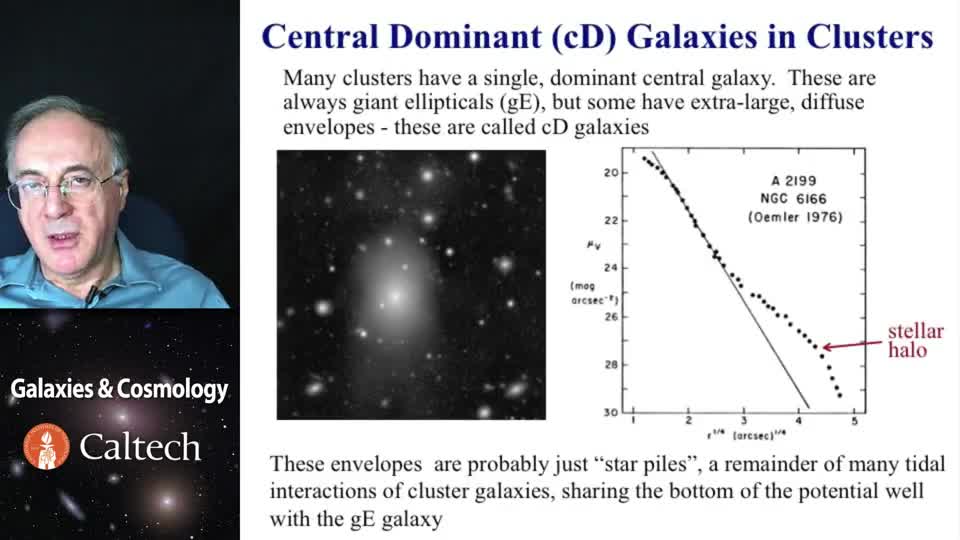Coursera - Galaxies and Cosmology
WEB-Rip | AVC1 @ 500 Kbit/s | 960x540 | AAC Stereo @ 128 Kbit/s 48 KHz | 60 Hours | 1.71 GB
Genre: Galaxies and Cosmology | Language: English | PDFs & English Subtitles Included
WEB-Rip | AVC1 @ 500 Kbit/s | 960x540 | AAC Stereo @ 128 Kbit/s 48 KHz | 60 Hours | 1.71 GB
Genre: Galaxies and Cosmology | Language: English | PDFs & English Subtitles Included
Galaxies and Cosmology
An introduction to the modern extragalactic astronomy and cosmology, the physical universe, big bang, formation and evolution of galaxies, quasars, and large-scale structure.
About the Course
This class is an introduction to the modern extragalactic astronomy and cosmology, i.e., the part of astrophysics that deals with the structure and evolution of the universe as a whole, and its major constituents: dark matter, dark energy, galaxies, quasars, large-scale structure, and intergalactic gas. It will cover the subjects including: relativistic cosmological models and their parameters, extragalactic distance scale, cosmological tests, composition of the universe, dark matter, and dark energy; the hot big bang, cosmic nucleosynthesis, recombination, and cosmic microwave background; formation and evolution of structure in the universe; galaxy clusters, large-scale structure and its evolution; galaxies, their properties and fundamental correlations; formation and evolution of galaxies; star formation history of the universe; quasars and other active galactic nuclei, and their evolution; structure and evolution of the intergalactic medium; diffuse extragalactic backgrounds; the first stars, galaxies, and the reionization era. It corresponds to the Ay 21 class taught at Caltech.
Course Syllabus
Galaxies and Cosmology
The lecture schedule and topics covered by this class are given below. There is no midterm or final for this class, but there are graded quizzes at the end of each week based on lecture material.
Week 1
Chapter 1: Introduction
Cosmology as a science
An overview of the modern cosmology and its history
Units, fluxes, and magnitudes
Chapter 2: Basics of Relativistic Cosmology
Basic concepts of General Relativity
Symmetry assumptions: homogeneity and isotropy
Metric, Robertson-Walker
The cosmological redshift
Comoving and proper coordinates
Friedmann equation
Definitions of cosmological parameters
Week 2
Chapter 3: Cosmological Models
Computing cosmological models
Distances in cosmology
Basics of cosmological tests
The cosmic horizons
Chapter 4: Distance Scale, Age of the Universe, and the Universal Expansion
Distance scale and the Hubble constant
The age of the universe
Tests of the universal expansion
Week 3
Chapter 5: Cosmological Tests
Classical cosmological tests and their problems
Modern tests (non-CMBR)
Tests using CMBR fluctuations
Chapter 6: The hot Big Bang and the Thermal History of the Universe
Planck era and beyond
Inflation
Baryosynthesis
Nucleosynthesis
Recombination
Reionization
Week 4
Chapter 7: Contents of the Universe
Luminous matter, M/L ratios
Baryons
Dark matters
Gravitational lensing
Dark energy, cosmological constant and quintessence
Chapter 8: Structure Formation: Theory
Density fluctuations, power spectrum, growth, damping
Dark matter dependence of cosmogony; Cold Dark Matter
Post-recombination growth
Collapse of density fluctuations
The role of cooling; galaxies vs. clusters and LSS
Numerical simulations
Galaxy merging
Week 5
Chapter 9: Observations of Large Scale Structure
Measurements of galaxy clustering and LSS
Redshift surveys
Chapter 10: Large Scale Structure and Clusters of Galaxies
Peculiar motions
Evolution of clustering
Biasing
Galaxy clusters and their properties
Week 6
Chapter 11: Galaxies, Their Structure and Properties (I)
Galaxy catalogs, morphological classification, Hubble sequence
Variation of galaxy properties along the Hubble Sequence
Stellar populations and galaxian subsystems
Galaxy luminosity and mass functions
Properties of spiral galaxies, density wave theory
Chapter 12: Galaxies, Their Structure and Properties (II)
Properties of elliptical galaxies
Supermassive black holes in nearby galaxies
Properties of dwarf galaxy families
Fundamental correlations, scaling relations, and their uses
Week 7
Chapter 13: Galaxy Evolution
Basic processes of galaxy evolution: merging, stellar pop. modeling
Deep surveys (imaging and redshift)
Selection effects and obscured star formation
Star formation history, assembly of the mass
The Olbers paradox
Optical/NIR and FIR/sub-mm diffuse backgrounds
Chapter 14: Chemical Evolution, Intergalactic Medium and its Evolution
Chemical evolution of galaxies
Basic phenomenology of absorbers
LyA forest, Lyman limit systems, Damped LyA systems
Evolution of IGM and its chemical enrichment
Feedback processes and the cosmic web
Week 8
Chapter 15: Galaxy Formation
Basics of galaxy formation
The first galaxies and early stages of galaxy evolution
Reionization era
The first stars
The origins of black holes in the early universe
Chapter 16: Quasars and Active Galactic Nuclei: Phenomenology and Physics
AGN properties, basics, classification, spectra
Supermassive black holes and their fueling
Emission mechanisms
AGN unification
Week 9
Chapter 17: Quasars and AGN: Unification, Evolution, High-Energy Backgrounds
Jets and beaming
Quasar surveys and evolution
X-ray, gamma-ray, and AGN-generated backgrounds
The origin of first quasars and supermassive black holes
Recommended Background
This class assumes at a minimum a prior knowledge of astronomy at a good mid-undergraduate level (e.g., “Astro 101” for science majors, not “Astro 1” for poets), knowledge of physics at a comparable level, and math at a level of calculus or higher. A substantive Wikipedia article is about at the right level.




